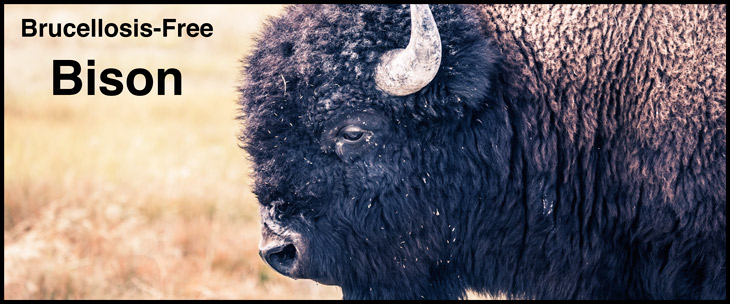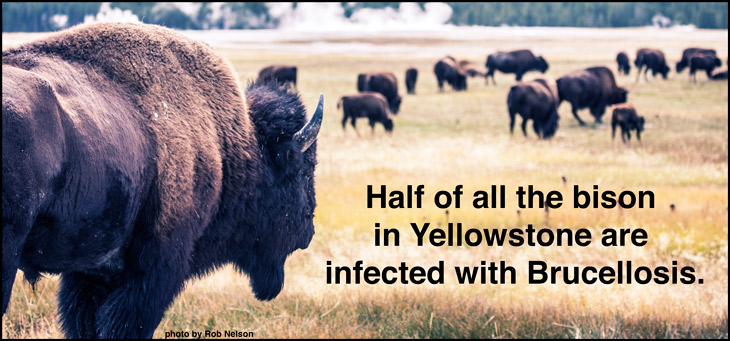Bringing Brucellosis-Free Bison Back to North America
Bison bison
Imagine a mountain of giant skulls of animals that people had killed. This haunting image is a real result of actions by settlers in the 1800s.
As they began moving westward across North America, settlers encountered huge herds of bison roaming the prairies and used their hides and meat to support a growing population. They would also collect the animals’ skulls and bones and grind them into fertilizer to enrich the new farmland they had created. Thus the iconic photos of piles of bison skulls awaiting grinding.
But this story is not about how bison neared extinction. This story is about how scientists are bringing them back.
What do you get when you cross a bison with a cow? A Beefalo.
Creating new bison populations from scratch is a tricky process. One of the main problems is that most of the existing animals aren’t even pure bison!
When people came to their senses in the settler days and realized that bison were on the brink of extinction, they decided to take drastic measures to save them. One of the things they tried was interbreeding them with cattle to create a hybrid that they called – I kid you not – beefalo.
50/50 beefalo hybrids aren’t especially common these days, but as a result of these early experiments, most bison in captive and wild settings still have tiny amounts of cattle genes. This means that while the bison we see are actually not 100% pure bison, for most intents and purposes, they are still generally considered bison.
Big Problems From Brucellosis-Infected Bison
When looking at reintroduction efforts, though, biologists want to release 100% genetically pure bison, not the ancestors of the beefalo. However, there are only a few remaining vestiges of genetically pure bison scattered in isolated places, including Yellowstone National Park, and these bison come with some excess baggage.
The Yellowstone bison herd is infected with a disease called brucellosis, which causes pregnant bison moms to abort their fetuses. Half of all the bison in Yellowstone are infected with this disease, and there is no cure. This isn’t ideal for reintroduction efforts and rebuilding populations of one of the most iconic species in North America.
Science to the Rescue!
This big problem needed a creative solution, and researchers at Colorado State University’s Animal Reproduction and Biotechnology Lab were up to the task. Their mission: figure out a way to get rid of the disease so that genetically pure bison could be reintroduced to North America, starting in Colorado.
Dr. Jennifer Barfield developed a way to take semen and embryos from Yellowstone bison and physically cleanse and remove the brucellosis bacteria from these microscopic materials. Once they are free of brucellosis, the semen can be used for artificial insemination and the embryos can be implanted in surrogate moms that are the disease-free beefalo ancestors. That way, the scientists created disease-free, genetically pure bison babies that could be reintroduced outside of Yellowstone.
The process worked extremely well. Due to these new methods and help from numerous city, county, and federal agencies, a small herd of 10 genetically pure bison was able to be released in northern Colorado in October 2015.
These bison are the first test in new reintroduction efforts that will hopefully allow herds of genetically pure bison to roam again in North America’s native landscapes, just like they did one hundred and fifty years ago.
Related Topics
Imagine a mountain of giant skulls of animals that people had killed. This haunting image is a real result of actions by settlers in the 1800s.
As they began moving westward across North America, settlers encountered huge herds of bison roaming the prairies and used their hides and meat to support a growing population. They would also collect the animals’ skulls and bones and grind them into fertilizer to enrich the new farmland they had created. Thus the iconic photos of piles of bison skulls awaiting grinding.
But this story is not about how bison neared extinction. This story is about how scientists are bringing them back.
What do you get when you cross a bison with a cow? A Beefalo.
Creating new bison populations from scratch is a tricky process. One of the main problems is that most of the existing animals aren’t even pure bison!
When people came to their senses in the settler days and realized that bison were on the brink of extinction, they decided to take drastic measures to save them. One of the things they tried was interbreeding them with cattle to create a hybrid that they called – I kid you not – beefalo.
50/50 beefalo hybrids aren’t especially common these days, but as a result of these early experiments, most bison in captive and wild settings still have tiny amounts of cattle genes. This means that while the bison we see are actually not 100% pure bison, for most intents and purposes, they are still generally considered bison.
Big Problems From Brucellosis-Infected Bison
When looking at reintroduction efforts, though, biologists want to release 100% genetically pure bison, not the ancestors of the beefalo. However, there are only a few remaining vestiges of genetically pure bison scattered in isolated places, including Yellowstone National Park, and these bison come with some excess baggage.
The Yellowstone bison herd is infected with a disease called brucellosis, which causes pregnant bison moms to abort their fetuses. Half of all the bison in Yellowstone are infected with this disease, and there is no cure. This isn’t ideal for reintroduction efforts and rebuilding populations of one of the most iconic species in North America.
Science to the Rescue!
This big problem needed a creative solution, and researchers at Colorado State University’s Animal Reproduction and Biotechnology Lab were up to the task. Their mission: figure out a way to get rid of the disease so that genetically pure bison could be reintroduced to North America, starting in Colorado.
Dr. Jennifer Barfield developed a way to take semen and embryos from Yellowstone bison and physically cleanse and remove the brucellosis bacteria from these microscopic materials. Once they are free of brucellosis, the semen can be used for artificial insemination and the embryos can be implanted in surrogate moms that are the disease-free beefalo ancestors. That way, the scientists created disease-free, genetically pure bison babies that could be reintroduced outside of Yellowstone.
The process worked extremely well. Due to these new methods and help from numerous city, county, and federal agencies, a small herd of 10 genetically pure bison was able to be released in northern Colorado in October 2015.
These bison are the first test in new reintroduction efforts that will hopefully allow herds of genetically pure bison to roam again in North America’s native landscapes, just like they did one hundred and fifty years ago.


































































































